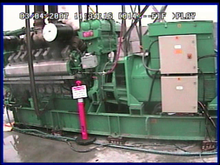
Idaho National Laboratory ran the Aurora Generator Test in 2007 to demonstrate how a cyberattack could destroy physical components of the electric grid.[1] The experiment used a computer program to rapidly open and close a diesel generator's circuit breakers out of phase from the rest of the grid, thereby subjecting the engine to abnormal torques and ultimately causing it to explode. This vulnerability is referred to as the Aurora Vulnerability.
This vulnerability is especially a concern because most grid equipment supports using Modbus and other legacy communications protocols that were designed without security in mind. As such, they do not support authentication, confidentiality, or replay protection. This means that any attacker that can communicate with the device can control it and use the Aurora Vulnerability to destroy it.